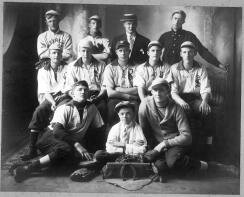These recollections were dictated by Richard Mertz of Shakopee in 1980 and originally shared in the collection “As I Remember Scott County”
Shakopee has been most fortunate in the type of people it has attracted over these many years. It has an interesting and colorful past so it us pure fun to remember and relate some of the most pleasant memories.
Today we have many nationalities and most of our families are such a mixture that we can only say we are Americans. Not so forty or fifty years ago when most of our families were first or second generation German - or a European nation of close proximity. All of our people are hardworking and completely honest, but English sentence structure was absolutely foreign and vocabulary was not unlike Archie Bunker’s
In one of the early grades, we had a kid who would say “I’m going the hall across”, which was much to the amusement of those who had moved to Shakopee from some town that had an English speaking background.
I recall the evening when five or six of us, all teenagers, were chatting at home not far from where we live today when a lady from out of state, visiting our friend’s mother, mentioned that there was a great deal of activity around the house.
“Ach Ja” she said, “This coming and this wenting and this wenting and this coming this is me something” . Many times she would call her husband George from the garden with “George, come once from the outside in the telephone is calling you”/
Another time a picnic was being planned when our neighbor lady said “Ach Ja No, we have to insulate our new minister that day”.
Over these many years I have enjoyed telling a story that occurred in about 1939 when Shakopee was hosting the State Baseball Tournament and Superintendent of Schools, John Metcalf (later a distinguished state senator) was the announcer. In those days we didn’t have a lighted ball field, so many of the games were played in the morning. John found it necessary to leave the press box which also served as the announcer’s office. He left just as there was an argument on the field that turned the microphone over to one of our leading fans who soon announced “Owatonna is playing this game under protest, claiming that the Beardsly left fielder is illegitimate”. It brought the house down, and I doubt if anyone an remember to this day who won the ball game
I wonder how many people remember the time that the Presbyterian Church bell was ringing every night at midnight? The town was rife with rumors and guards took up posts around the church - all to no avail. The bell kept ringing at the appointed hour. Eventually, some brave soul climbed to the tower in daylight. There he found numerous chunks of lead from 22 rifle shots fired by one of the town characters.
Or the days when Scott County ha slot machines in almost every bar (Shakopee had over 30 bars at the time), barbershop, and gas station. Liquor was served in the 3.2 beer bars. Every time the state liquor control officers came into the county, phones rang at all those 3.2 bars warning the bartenders of a possible raid. On one such occasion a feisty Irishman had hardly hung up the phone when two men in suits arrived and sat in a booths. Now most people didn’t wear a suit until Saturday, so this was a dead giveaway. Then, sitting in a booth confirmed the worst because no one ever sat in a booth unless he had a wife or girlfriend along - or unless he was a liquor control agent. One order charged water, the other ginger ale, Mac, the Irishman, went behind the bar, returned with the drinks, and rang up the register. The agents announced that there was no liquor in their drinks. Mac just said that it was policy of the house not to serve liquor to liquor control agents. The other patrons howled with laughter, and the agents left hurriedly without drinking their soft drinks.






